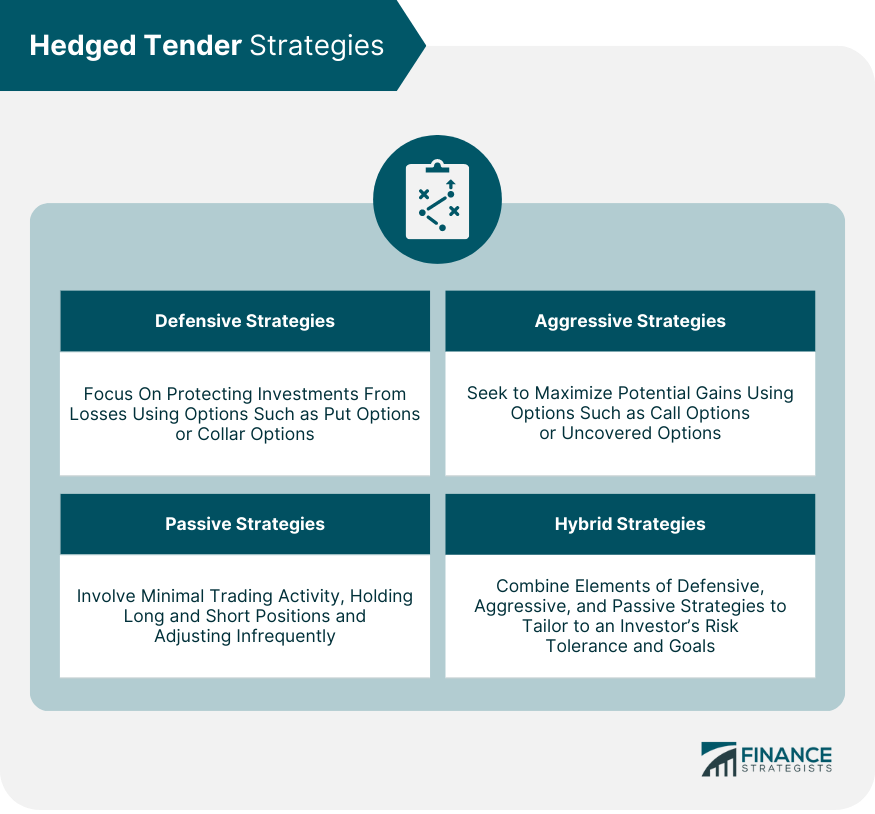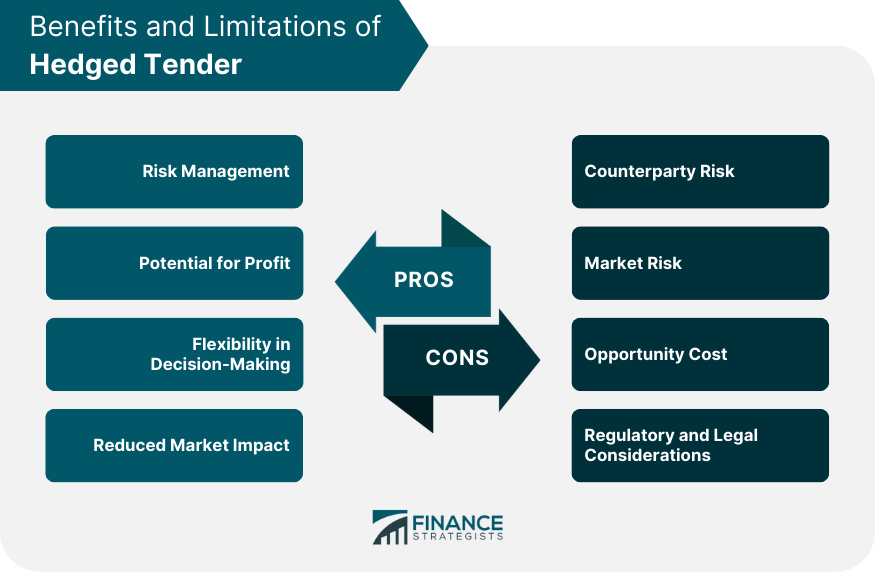Hedged tender is an investment strategy employed in the financial markets. Investors use this method to protect their investments from market volatility when a company announces a tender offer. The strategy involves the investor tendering his shares, while simultaneously short selling the stock in the open market, protecting himself from a potential fall in price. Hedged tender plays a critical role in the financial markets. It facilitates more effective risk management, enabling investors to mitigate potential losses in volatile market conditions. The strategy also fosters price stability by reducing the impact of large sales on the stock's price. It is a key element in complex financial transactions like mergers and acquisitions. Beyond the financial sector, hedged tender is applicable in other areas where tender offers are common. In the technology sector, it helps investors navigate the uncertainty of merger deals. In the pharmaceutical industry, it's used to mitigate risks associated with regulatory decisions. It's also prevalent in the energy sector, especially in cases of potential buyouts. In a put-option hedged tender, an investor buys put options to hedge against a potential decrease in the stock's price. This strategy allows the investor to sell the stock at a pre-determined price, effectively limiting the downside risk. A call-option hedged tender is the opposite of the put-option strategy. Here, the investor sells call options. This approach allows the investor to generate income from the option premiums while potentially benefiting from a price increase in the stock. The collar-option hedged tender involves buying a put option and selling a call option simultaneously. This strategy creates a safety "collar" around the investment, protecting the investor from extreme market movements in either direction. Each type of hedged tender offers unique benefits and drawbacks. Put-option hedged tenders provide downside protection but limit potential profits. Call-option hedged tenders generate immediate income but expose the investor to potentially significant losses if the stock's price rises significantly. Collar-option hedged tenders offer balanced protection, but they limit both potential losses and gains. Hedge funds are significant players in the hedged tender market. They often use advanced hedged tender strategies to manage risk and generate profits. Investment banks play a crucial role as intermediaries in the hedged tender market. They facilitate transactions and provide investors with access to the necessary financial instruments. Corporations, particularly those involved in mergers and acquisitions, are key players in the hedged tender market. Their activities often provide the opportunities for investors to use hedged tender strategies. Individual investors, though less prominent than institutional players, also participate in the hedged tender market. Advanced individual investors may use hedged tender strategies to manage risk in their personal portfolios. Defensive hedged tender strategies focus on protecting investments from losses. Investors using this approach might employ put options or collar options to limit downside risk. These strategies are popular in unstable market conditions. Aggressive strategies seek to maximize potential gains. Investors may use call options or even uncovered options in a bid to enhance returns. These strategies carry more risk but offer potentially higher rewards. Passive hedged tender strategies involve minimal trading activity. The investor may hold a mix of long and short positions and adjust them infrequently. This strategy is popular with investors who want to hedge their risk without actively managing their portfolio. Hybrid hedged tender strategies combine elements of the defensive, aggressive, and passive strategies. For example, an investor might use a collar option strategy (defensive) while also selling uncovered options (aggressive). Hybrid strategies can be tailored to suit an investor's risk tolerance and investment goals. Hedged tender offers investors an effective risk management tool. It helps mitigate losses from market volatility, providing a layer of security for investments. While hedged tender is primarily a risk management tool, it also presents opportunities for profit. By strategically using options in conjunction with their stock holdings, investors can generate additional income and potentially realize higher returns. Hedged tender strategies offer flexibility. Investors can adjust their strategies based on market conditions, risk tolerance, and investment goals. This adaptability is especially valuable in volatile or uncertain market conditions. Large sales of stock can significantly impact the market price. By using hedged tender strategies, investors can reduce this market impact, helping to maintain price stability. Counterparty risk is a significant consideration in hedged tender strategies. If the party on the other side of an option contract fails to fulfill their obligations, the investor may experience losses. Despite the protective features of hedged tender strategies, they can't completely eliminate market risk. If the market moves in an unfavorable direction, investors can still experience losses. Hedged tender strategies can limit potential profits. For example, if an investor uses a put option to protect against a price drop and the stock's price rises instead, the investor will miss out on potential profits. Hedged tender strategies are subject to regulatory scrutiny. Investors must adhere to rules and regulations around short selling and options trading. Failure to do so can result in significant penalties. In mergers and acquisitions, companies often issue tender offers for the target company's shares. Investors can use hedged tender strategies to protect their investments during this potentially volatile period. Hedged tender strategies can influence deal negotiations and outcomes. When many investors use these strategies, it can signal market skepticism about the deal, potentially influencing the terms and even the final outcome. Regulatory authorities such as the Securities and Exchange Commission (SEC) in the United States oversee the hedged tender market. They ensure market transparency and protect investors by enforcing rules and regulations. Rules around short selling, options trading, and tender offers are among the key regulations in the hedged tender market. These rules aim to protect investors and maintain fair and orderly markets. Compliance best practices in the hedged tender market include keeping up-to-date with regulatory changes, maintaining rigorous record-keeping, and adhering to ethical standards. An experienced financial advisor or compliance professional can provide valuable guidance. Hedged tender is an investment strategy used to manage risk in the face of market volatility, particularly during tender offers in mergers and acquisitions. It involves a combination of tendering shares and short selling, providing a protective hedge for the investor. Hedged tender strategies play a vital role in the financial markets, providing investors with a means to protect their investments from market volatility and manage risk effectively. These strategies offer various options, such as put-option hedged tender, call-option hedged tender, collar-option hedged tender, and hybrid strategies, allowing investors to tailor their approach based on their risk tolerance and investment goals. While hedged tender strategies offer benefits such as risk management, potential for profit, flexibility in decision-making, and reduced market impact, they also come with risks and limitations, including counterparty risk, market risk, opportunity cost, and regulatory and legal considerations. Compliance with regulatory authorities, such as the Securities and Exchange Commission, is crucial in the hedged tender market, and adherence to rules and regulations, along with compliance best practices, ensures market transparency and investor protection. Hedged tender strategies can be complex and involve significant risks. It's advisable to seek guidance from a financial advisor or investment professional before engaging in these strategies.What Is Hedged Tender?
Types of Hedged Tender
Put-Option Hedged Tender
Call-Option Hedged Tender
Collar-Option Hedged Tender
Comparing Different Types
Key Players in the Hedged Tender Market
Hedge Funds
Investment Banks
Corporations
Individual Investors
Hedged Tender Strategies
Defensive Strategies
Aggressive Strategies
Passive Strategies
Hybrid Strategies

Benefits of Hedged Tender
Risk Management
Potential for Profit
Flexibility in Decision-Making
Reduced Market Impact
Risks and Limitations of Hedged Tender
Counterparty Risk
Market Risk
Opportunity Cost
Regulatory and Legal Considerations

Hedged Tender in Mergers and Acquisitions
Role in Tender Offers
Impact on Deal Negotiations and Outcomes
Hedged Tender Regulations and Compliance
Relevant Regulatory Authorities
Key Rules and Regulations
Compliance Best Practices
Final Thoughts
Hedged Tender FAQs
Hedged tender is an investment strategy used to manage risk during tender offers in mergers and acquisitions. It involves tendering shares and simultaneously short selling the same stock.
Benefits of hedged tender include effective risk management, potential for profit, decision-making flexibility, and reduced market impact.
Risks include counterparty risk, market risk, opportunity cost, and regulatory and legal considerations.
Key players include hedge funds, investment banks, corporations, and individual investors.
Regulatory authorities oversee the hedged tender market to ensure transparency and protect investors. They enforce rules and regulations around short selling, options trading, and tender offers.
True Tamplin is a published author, public speaker, CEO of UpDigital, and founder of Finance Strategists.
True is a Certified Educator in Personal Finance (CEPF®), author of The Handy Financial Ratios Guide, a member of the Society for Advancing Business Editing and Writing, contributes to his financial education site, Finance Strategists, and has spoken to various financial communities such as the CFA Institute, as well as university students like his Alma mater, Biola University, where he received a bachelor of science in business and data analytics.
To learn more about True, visit his personal website or view his author profiles on Amazon, Nasdaq and Forbes.











